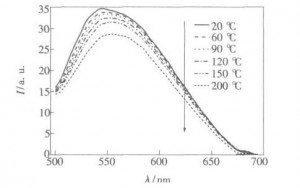In the previous section, we discussed about the impact of temperature on fluorescent powder. With the increase of temperature, activities of fluorescent powder will decrease. At the same time, temperature will also affect the wavelength of light. Feature below illustrates the relation between temperature and the wavelength. We can see that with the increase of temperature, the wavelength of light emitted though fluorescent powder will red shift. In other words, CRI for LEDs of led lights will be improved (more red rays). It is contradictory to the previous statement: CRI for LEDs will decrease as temperature increases. As a matter of fact, the red shift of fluorescent powder is negligible compare with the degeneration of fluorescent powder. Overall, when temperature drops the CRI for LEDs is actually decreases.
According to above analysis, there are three solutions: reduce PN junction temperatures; improve the adaptability of fluorescent powder in high temperatures; use color compensation technology (use red led street light or amber LEDs to compensate the CRI for LEDs);
The most effective solution in reducing PN junction temperatures is to design new LED packaging methods with better heat radiating performances. This is one of our development directions that can have Chinese LED industry to make significant progress in intellectual property in the near future. Since LED is a type of low-voltage electronic products, there are not many strict requirements on electrical safety. Thus a lot of heat radiating materials can be used as LED bases. But Chinese LED flood lights manufacturers have not taken enough research on this part, leading to some foreign intellectual property disputes. Improving the adaptability of fluorescent powder in high temperatures is main research area in international LED technology. Chinese current technique in this respect is relatively weak and cannot break through this bottleneck in the short term. The color compensation technique can improve CRI for LEDs though making up the deficient colors. Theoretically, this solution is feasible. But in real life, there are many restrictions in color mixing technique, with no practical value.
Except for the above three solutions, scientists are trying hard to find other methods which can improve the degeneration of fluorescent powder. CRI problem is the main obstacle for LED lamps to replace traditional lamps completely. It is significant to improve CRI for LEDs.

